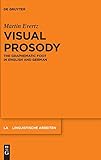Visual Prosody : The Graphematic Foot in English and German / Martin Evertz.
Material type: TextSeries: Linguistische Arbeiten ; 570Publisher: Berlin ; Boston : De Gruyter, [2018]Copyright date: ©2018Description: 1 online resource (VIII, 239 p.)Content type:
TextSeries: Linguistische Arbeiten ; 570Publisher: Berlin ; Boston : De Gruyter, [2018]Copyright date: ©2018Description: 1 online resource (VIII, 239 p.)Content type: - 9783110581089
- 9783110581195
- 9783110583441
- 431.5 23
- PF3131 .E947 2018
- online - DeGruyter
- Issued also in print.
| Item type | Current library | Call number | URL | Status | Notes | Barcode | |
|---|---|---|---|---|---|---|---|
 eBook
eBook
|
Biblioteca "Angelicum" Pont. Univ. S.Tommaso d'Aquino Nuvola online | online - DeGruyter (Browse shelf(Opens below)) | Online access | Not for loan (Accesso limitato) | Accesso per gli utenti autorizzati / Access for authorized users | (dgr)9783110583441 |
Frontmatter -- Acknowledgements -- Contents -- 1. Introduction -- 2. Features, Letters and Graphemes -- 3. The Graphematic Syllable -- 4. The Graphematic Foot -- 5. Conclusion -- Bibliography -- Appendix
restricted access online access with authorization star
http://purl.org/coar/access_right/c_16ec
According to well-established views, language has several subsystems where each subsystem (e.g. syntax, morphology, phonology) operates on the basis of hierarchically organised units. When it comes to the graphematic structure of words, however, the received view appears to be that linear structure is all that matters. Contrary to this view, a sub-field of writing systems research emerges that can be called non-linear or supra-segmental graphematics. Drawing on parallels with supra-segmental phonology, supra-segmental graphematics claims the existence and relevance of cross-linguistically available building blocks, such as the syllable and the foot, in alphabetical writing systems, such as the writing systems of German and English. This book explores the graphematic hierarchy with a special focus on the unit foot. Structural, experimental and databased evidence is presented in favour of this approach. In addition, analyses within the optimality theory framework are offered. This work shows that the supra-segmental graphematic approaches are superior to linear ones with respect to explanatory strength and even preciseness of the description. It is thus interesting for academics concerned with writing systems and orthography teaching.
Issued also in print.
Mode of access: Internet via World Wide Web.
In English.
Description based on online resource; title from PDF title page (publisher's Web site, viewed 25. Jun 2024)


